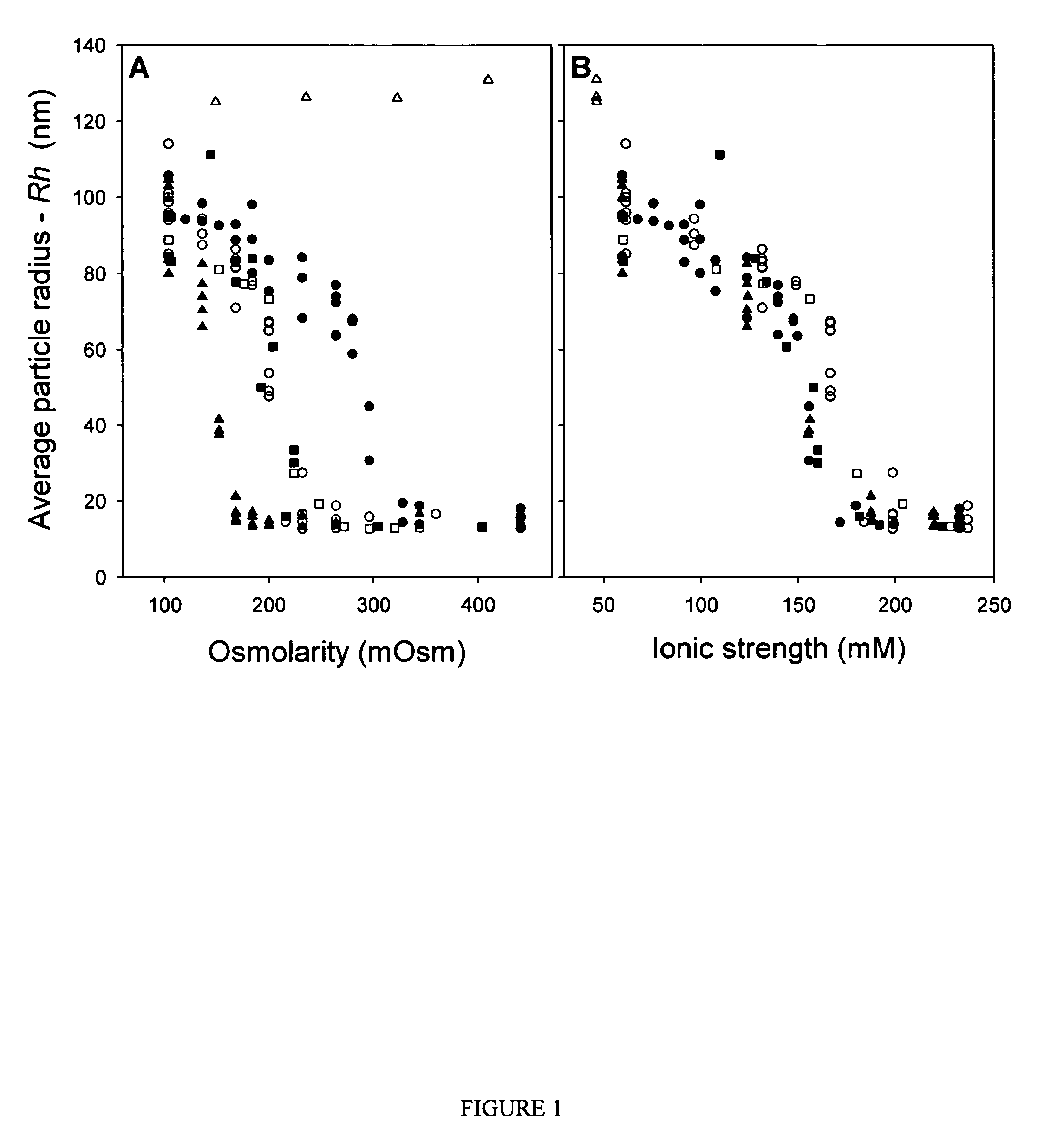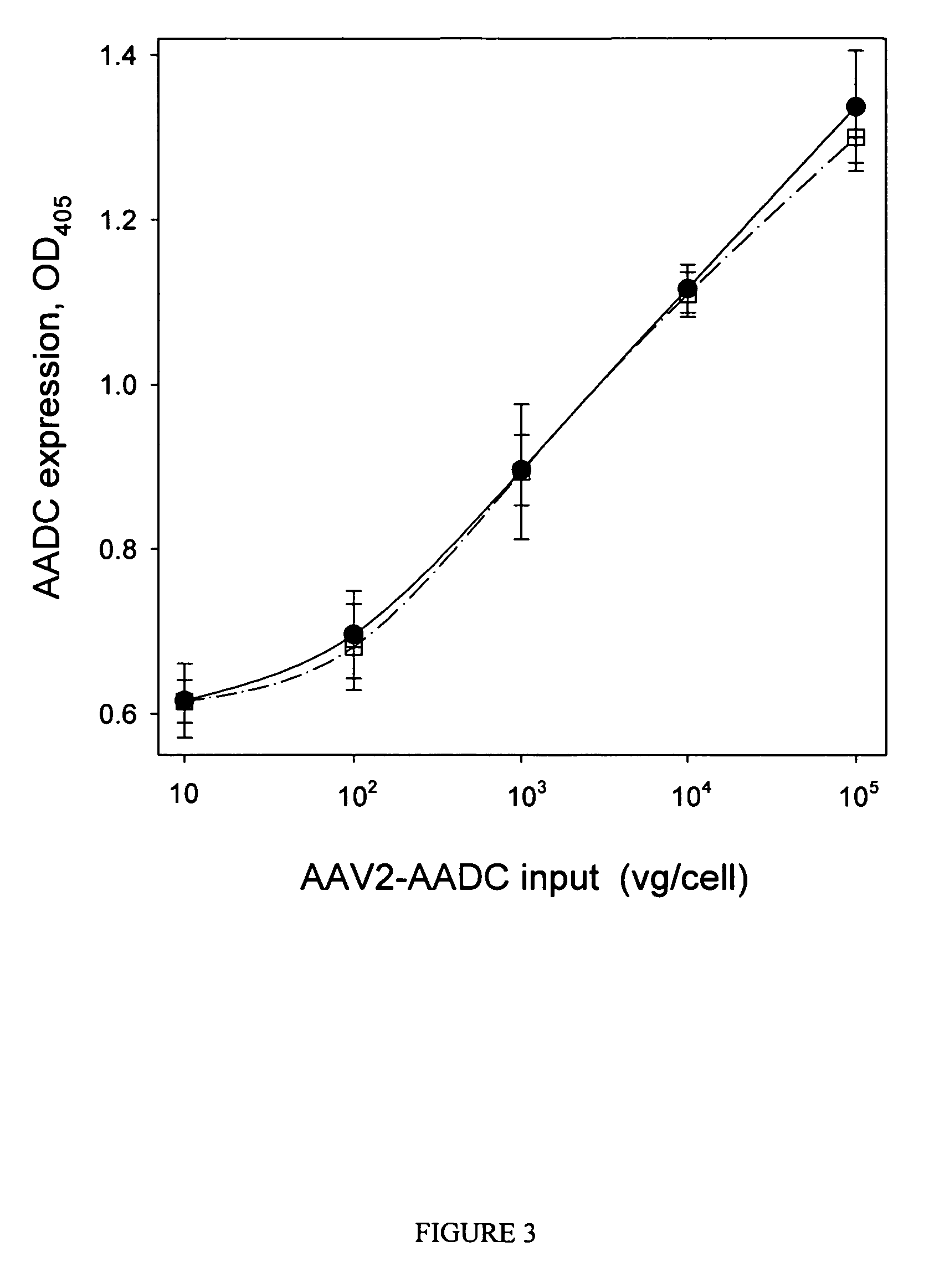Compositions and methods to prevent AAV vector aggregation
a technology of aav virus and aav2 particles, applied in the field of compositions and methods of preparing and storing aav virus, can solve the problems of particle aggregation, significant particle aggregation, and insufficient resolution of particle aggregation, and achieve high infectivity titer and transduction efficiency, high ionic strength, and high titer. the effect of titer
- Summary
- Abstract
- Description
- Claims
- Application Information
AI Technical Summary
Benefits of technology
Problems solved by technology
Method used
Image
Examples
example 1
[0057]AAV2 vectors expressing human coagulation factor IX (FIX) or human amino acid decarboxylase (AADC) are produced by triple transfection of HEK293 cells as previously described (Matsushita, T. et al. (1998) Gene Therapy 5: 938-945), with modifications. For the large scale preparations, cells are cultured and transfected in 850 mm2 roller bottles (Corning). Vectors are purified by one of three methods.
[0058]In purification Method 1, modified from Matsushita, transfected HEK293 cells in roller bottles are collected by centrifugation (1000 g, 15 min), resuspended in 10 mM sodium phosphate, 500 mM sodium chloride, pH 7.2, and lysed by three freeze / thaw cycles (alternating an ethanol / dry ice bath and a 37° C. water bath). The cell lysate is clarified by centrifugation (8,000 g, 15 min). The supernatant is then diluted to 200 mM NaCl by addition of 10 mM sodium phosphate, pH 7.2, and digested with Benzonase® (Merck, Purity Grade 1; 200 U / mL, 1 h, 37° C.). The l...
example 2
Ultrafiltration and Diafiltration to Detect AAV Aggregation
[0063]Disposable hollow fiber tangential flow filtration devices (Amersham BioSciences 8″ Midgee, 100 kDa nominal pore size) are used to concentrate and diafilter AAV2 vectors purified by the methods described above, and for the UF / DF experiments described in Table 2. For all UF / DF procedures a volume of diafiltration buffer corresponding to 10× the product volume is used, and it is added in ˜1 mL increments to approximate continuous diafiltration. Using this method, the calculated residual CsCl after diafiltration is <0.5 mM.
[0064]The following three formulations were used for UF / DF: Control Formulation (CF: 140 mM sodium chloride, 10 mM sodium phosphate, 5% sorbitol, pH 7.3); Test Formulation 1 (TF1: 150 mM sodium phosphate, pH7.5); and Test Formulation 2 (TF2: 100 mM sodium citrate, 10 mM Tris, pH8.0). For Experiment 1 shown in Table 2, diafiltration is performed at a volume corresponding to a vector concentration of 1×10...
example 3
Measurement of Vector Aggregation by Dynamic Light Scattering
[0067]Purified vectors are analyzed for aggregation by dynamic light scattering (DLS) using a Protein Solutions DynaPro 99 (λ=825.4 nm). Primary data (particle radius—Rh, average value measured over 30 cycles, 10 cycles / min) are used for all analyses reported. A “dilution-stress” method is used to assess the effect of varying excipients on vector aggregation. In this method, 80 μL of test diluent is added to 20 μL of vector solution with mixing in the actual cuvette used for DLS measurement, and data collection is initiated within 10 seconds of mixing. Prior to addition of test diluents, the Rh value for AAV2 vector preparations is measured and confirmed to be <15 nm to ensure that the starting material is monomeric. Samples that are not 100% monomeric are passed through a 0.22 μm syringe disc filter (Sartorius, low protein binding) to remove aggregates.
[0068]The osmolarity and ionic strength values given in FIGS. 1 and 2 ...
PUM
| Property | Measurement | Unit |
|---|---|---|
| ionic strength | aaaaa | aaaaa |
| osmolarity | aaaaa | aaaaa |
| average particle radius | aaaaa | aaaaa |
Abstract
Description
Claims
Application Information
 Login to View More
Login to View More - R&D
- Intellectual Property
- Life Sciences
- Materials
- Tech Scout
- Unparalleled Data Quality
- Higher Quality Content
- 60% Fewer Hallucinations
Browse by: Latest US Patents, China's latest patents, Technical Efficacy Thesaurus, Application Domain, Technology Topic, Popular Technical Reports.
© 2025 PatSnap. All rights reserved.Legal|Privacy policy|Modern Slavery Act Transparency Statement|Sitemap|About US| Contact US: help@patsnap.com



